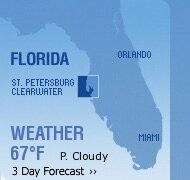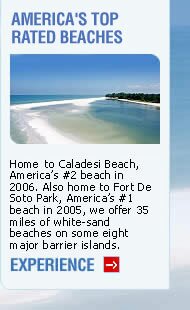| |
  
|

 |
|
 |
|
You Are Here: Home » Discover Us » History » Original Artifacts »
Indian Mounds are a historic curiosity at several spots along the Florida�s Beach area.
By Terry Tomalin
Driving through the sleepy little neighborhood of Pinellas Point, it�s easy to overlook what many consider to be one of the best-preserved historic sites along Florida�s Beach.
One thousand years ago, Tocabaga Indians gathered here by the hundreds to feast on oysters and clams, the shells of which helped build up the very ground you see rising 16 feet before you.
As a matter of fact, travel along the waterfront in any of the area�s undeveloped coastal parks and you can rest assured that any change of elevation that you see, even one as little as two feet, was probably made by the peninsula�s original inhabitants.
If you could travel back in time 1,000 years and fly from Tarpon Springs to Safety Harbor, then follow the shoreline of Tampa Bay to Weedon Island and Maximo Point, you would have seen thousands of people working and playing in the very same waters that attracts visitors today.
Along the coast, from what is now Tierra Verde and Ft. De Soto Park, then up then the Intracoastal Waterway to John�s Pass and along the beach to Clearwater, the Lost Tribes of Florida found the sea a veritable supermarket upon which to feed.
In many places, all these Indians left behind was piles of refuse, i.e., shells, but in some sites, such as the one located near 21st Street S. in St. Petersburg, they built mounds to support their temples.
The Pinellas Point Temple Mound is probably one of the best known of the more than 1,800 archeological sites along Florida�s Beach, thanks in part to a legend that accompanies it. Many believe the story of Juan Ortiz, a shipwrecked sailor saved from death by a beautiful Tocobaga princess, inspired the story of Capt. John Smith and Pocahontas some 80 years later.
According to a plaque on the south side of the mound, in 1528 Ortiz found himself at the mercy of Chief Hirrihigua, who hated the newcomers to his land because of the cruel things the conquistador Panfilo de Narvaez had done to his people. Princess Hirrihigua begged for the Spaniard�s life, and when it appeared that he may be killed, she helped him escape to another Indian village.
That colorful story, true or not, has helped earn the Pinellas Point Temple Mound international notoriety. Visitors still can climb the gentle sloping mound (access from Serpentine Circle, off 21st Street S.) and sit beneath a shady oak and wonder what life was like 1,000 years ago.
Another well-known, pre-Columbian Indian site can be found off Park Street at Jungle Prada where Narvaez, now seen as a tyrant, came ashore to start his ill-fated march across the American Southeast.
At the time of the Narvaez landing, the Jungle Prada area (now the site of a City of St. Petersburg Park) was the site of a thriving Indian village. A nearby shell mound, or midden as they are called, has been excavated by professional archeologists who dated the site to around 1,000 A.D. The mounds at Jungle Prada make an excellent half-day trip. To get there, turn west off of Park Street toward Boca Ciega Bay, at Elbow Lane N. Park on the south side of the street at Jungle Prada Park.
The largest mound complex in the Florida�s Beach area can be found in Safety Harbor�s Philippe Park. When Columbus landed in the New World, the Safety Harbor site served the central village of the Tocobaga and home of their cacique, or chief.
Another conquistador, Hernando De Soto, visited this capital of the Tocobaga, whose name loosely translates to �the place of the gourds.� Measuring 20-feet high and roughly 50- by 100-feet at the top, the mound at Philippe Park is undoubtedly the best-maintained and most easily accessible Indian Mound in the area.
The Safety Harbor Site has been designated as a Registered National Historic Landmark. Near the temple mound, archaeologists excavated a burial mound and unearthed more than 100 skeletons and ceremonial pottery.
The people who inhabited the Philippe Park now are described as the Safety Harbor Culture, the latest in a long-line of Native American cultures that existed before European contact.
After visiting Philippe Park, you can learn more about the Tocobaga and Safety Harbor Culture by visiting the Safety Harbor Museum, 329 South Bayshore Blvd. The St. Petersburg Museum of History, 335 2nd Ave. N.E., on the approach to The Pier, is also worth a visit.
|
|
 |
|
 |
|
|
|


